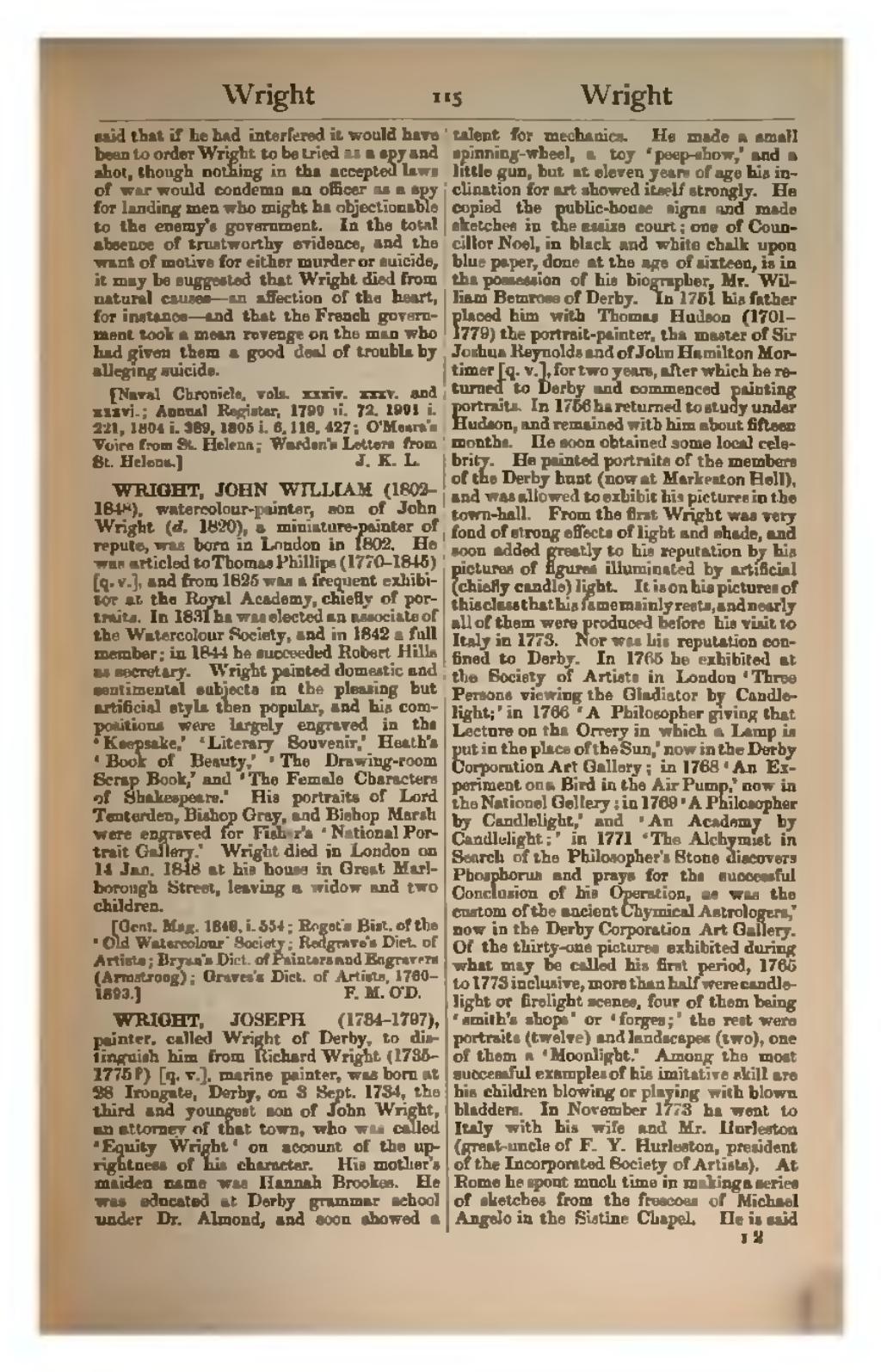said that if he had interfered it would have been to order Wright to be tried as a spy and shot, though nothing in the accepted laws of war would condemn an officer as a spy for landing men who might be objectionable to the enemy's government. In the total absence of trustworthy evidence, and the want of motive for either murder or suicide, it may be suggested that Wright died from natural causes—an affection of the heart, for instance—and that the French government took a mean revenge on the man who had given them a good deal of trouble by alleging suicide.
[Naval Chronicle, vols. xxxiv. xxxv. and xxxvi.; Annual Register, 1799 ii. 72, 1801 i. 221, 1804 i. 389, 1805 i. 6, 118, 427; O'Meara's Voice from St. Helena; Warden's Letters from St. Helena.]
WRIGHT, JOHN WILLIAM (1802–1848), watercolour-painter, son of John Wright (d. 1820), a miniature-painter of repute, was born in London in 1802. He was articled to Thomas Phillips (1770–1845) [q. v.], and from 1825 was a frequent exhibitor at the Royal Academy, chiefly of portraits. In 1831 he was elected an associate of the Watercolour Society, and in 1842 a full member; in 1844 he succeeded Robert Hills as secretary. Wright painted domestic and sentimental subjects in the pleasing but artificial style then popular, and his compositions were largely engraved in the ‘Keepsake,’ ‘Literary Souvenir,’ Heath's ‘Book of Beauty,’ ‘The Drawing-room Scrap Book,’ and ‘The Female Characters of Shakespeare.’ His portraits of Lord Tenterden, Bishop Gray, and Bishop Marsh were engraved for Fisher's ‘National Portrait Gallery.’ Wright died in London on 14 Jan. 1848 at his house in Great Marlborough Street, leaving a widow and two children.
[Gent. Mag. 1848, i. 554; Roget's Hist. of the ‘Old Watercolour’ Society; Redgrave's Dict. of Artists; Bryan's Dict. of Painters and Engravers (Armstrong); Graves's Dict. of Artists, 1760–1893.]
WRIGHT, JOSEPH (1734–1797), painter, called Wright of Derby, to distinguish him from Richard Wright (1735–1775?) [q. v.], marine painter, was born at 28 Irongate, Derby, on 3 Sept. 1734, the third and youngest son of John Wright, an attorney of that town, who was called ‘Equity Wright’ on account of the uprightness of his character. His mother's maiden name was Hannah Brookes. He was educated at Derby grammar school under Dr. Almond, and soon showed a talent for mechanics. He made a small spinning-wheel, a toy ‘peep-show,’ and a little gun, but at eleven years of age his inclination for art showed itself strongly. He copied the public-house signs and made sketches in the assize court; one of Councillor Noel, in black and white chalk upon blue paper, done at the age of sixteen, is in the possession of his biographer, Mr. William Bemrose of Derby. In 1751 his father placed him with Thomas Hudson (1701–1779) the portrait-painter, the master of Sir Joshua Reynolds and of John Hamilton Mortimer [q. v.], for two years, after which he returned to Derby and commenced painting portraits. In 1756 he returned to study under Hudson, and remained with him about fifteen months. He soon obtained some local celebrity. He painted portraits of the members of the Derby hunt (now at Markeaton Hall), and was allowed to exhibit his pictures in the town-hall. From the first Wright was very fond of strong effects of light and shade, and soon added greatly to his reputation by his pictures of figures illuminated by artificial (chiefly candle) light. It is on his pictures of this class that his fame mainly rests, and nearly all of them were produced before his visit to Italy in 1773. Nor was his reputation confined to Derby. In 1765 he exhibited at the Society of Artists in London ‘Three Persons viewing the Gladiator by Candlelight;’ in 1766 ‘A Philosopher giving that Lecture on the Orrery in which a Lamp is put in the place of the Sun,’ now in the Derby Corporation Art Gallery; in 1768 ‘An Experiment on a Bird in the Air Pump,’ now in the National Gallery; in 1769 ‘A Philosopher by Candlelight,’ and ‘An Academy by Candlelight;’ in 1771 ‘The Alchymist in Search of the Philosopher's Stone discovers Phosphorus and prays for the successful Conclusion of his Operation, as was the custom of the ancient Chymical Astrologers,’ now in the Derby Corporation Art Gallery. Of the thirty-one pictures exhibited during what may be called his first period, 1765 to 1773 inclusive, more than half were candlelight or firelight scenes, four of them being ‘smith's shops’ or ‘forges;’ the rest were portraits (twelve) and landscapes (two), one of them a ‘Moonlight.’ Among the most successful examples of his imitative skill are his children blowing or playing with blown bladders. In November 1773 he went to Italy with his wife and Mr. Hurleston (great-uncle of F. Y. Hurleston, president of the Incorporated Society of Artists). At Rome he spent much time in making a series of sketches from the frescoes of Michael Angelo in the Sistine Chapel. He is said
